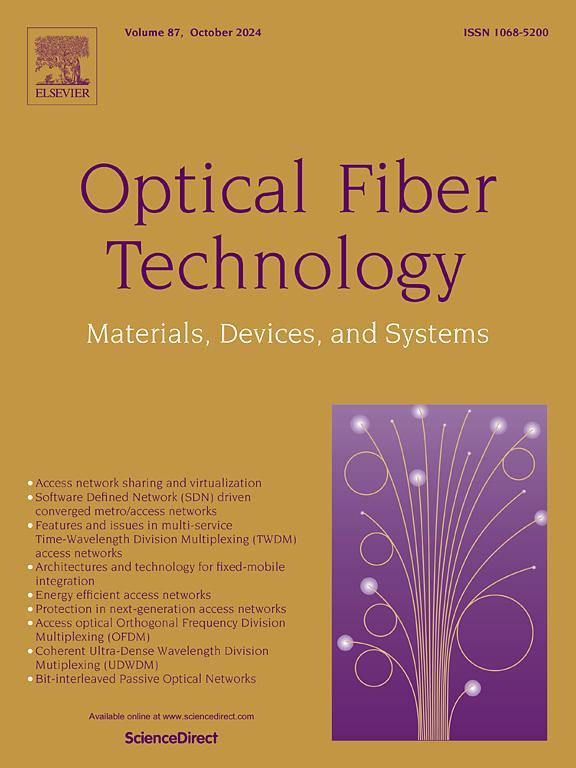利用直列六模光纤滤波器可调谐o波段双波长掺铋光纤激光器
IF 2.7
3区 计算机科学
Q2 ENGINEERING, ELECTRICAL & ELECTRONIC
引用次数: 0
摘要
本文设计了一种波长为1.3 μm的可调谐双波长光纤激光器。采用掺铋光纤(BDF)作为增益介质,采用直列六模光纤滤波器(SMFF)实现了o波段激光。该DWFL可通过可调带通滤波器(TBPF)进行调谐。在1324.6 nm和1324.87 nm处实现了DWFL,信噪比(SNRs)约为59 dB。双波长间隔为0.27 nm,符合SMFF在o波段产生的自由光谱范围(FSR)。通过手动调节TBPF,实现了从1319.72 nm (λ1)和1319.99 nm (λ2)到1328.58 nm (λ1)和1328.85 nm (λ2)的连续调谐。o波段区域的调谐范围约为9 nm,取决于腔内使用的增益光纤。这些1.3 μm的可调谐dwfl在高速波分复用(WDM)系统中具有潜在的应用前景。本文章由计算机程序翻译,如有差异,请以英文原文为准。
Tunable dual-wavelength bismuth-doped fiber laser in O-band using in-line six-mode fiber filter
A tunable dual-wavelength fiber laser (DWFL) is presented in this work at the 1.3 μm region. The O-band lasing was achieved using bismuth-doped fiber (BDF) as a gain medium, and the in-line six-mode fiber filter (SMFF) was used for DWFL operation. This DWFL was tunable by using the tunable-bandpass filter (TBPF). The DWFL was realized at 1324.6 and 1324.87 nm, achieving signal-to-noise ratios (SNRs) of approximately 59 dB. The dual-wavelength was attained at a spacing of 0.27 nm, which matches the free-spectral range (FSR) generated by the SMFF in the O-band region. By manually adjusting the TBPF, continuous tuning was achieved from 1319.72 nm (λ1) and 1319.99 nm (λ2) to 1328.58 nm (λ1) and 1328.85 nm (λ2), respectively. The O-band region’s tuning range was about 9 nm, depending on the gain fiber used within the cavity. These tunable DWFLs at 1.3 μm have potential applications for high-speed wavelength division multiplexing (WDM) systems.
求助全文
通过发布文献求助,成功后即可免费获取论文全文。
去求助
来源期刊

Optical Fiber Technology
工程技术-电信学
CiteScore
4.80
自引率
11.10%
发文量
327
审稿时长
63 days
期刊介绍:
Innovations in optical fiber technology are revolutionizing world communications. Newly developed fiber amplifiers allow for direct transmission of high-speed signals over transcontinental distances without the need for electronic regeneration. Optical fibers find new applications in data processing. The impact of fiber materials, devices, and systems on communications in the coming decades will create an abundance of primary literature and the need for up-to-date reviews.
Optical Fiber Technology: Materials, Devices, and Systems is a new cutting-edge journal designed to fill a need in this rapidly evolving field for speedy publication of regular length papers. Both theoretical and experimental papers on fiber materials, devices, and system performance evaluation and measurements are eligible, with emphasis on practical applications.
 求助内容:
求助内容: 应助结果提醒方式:
应助结果提醒方式:


